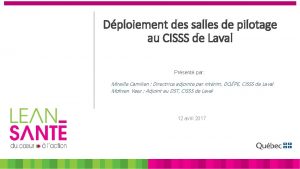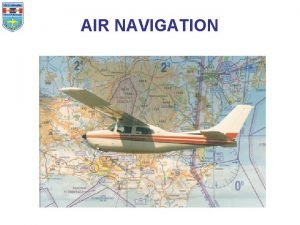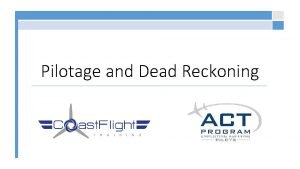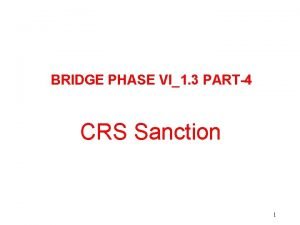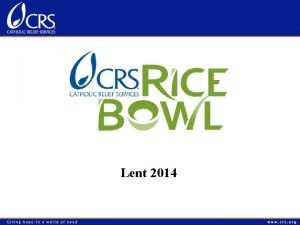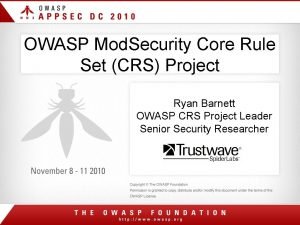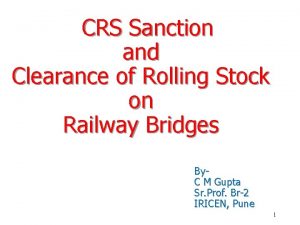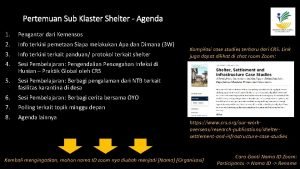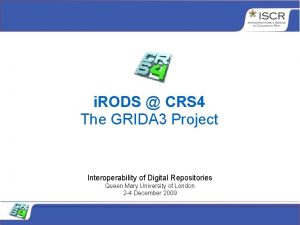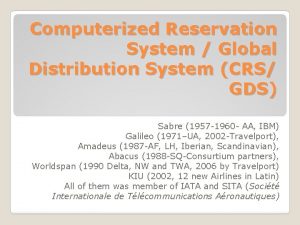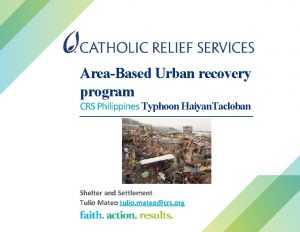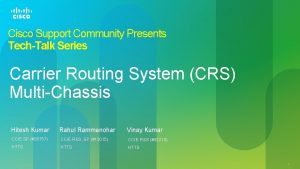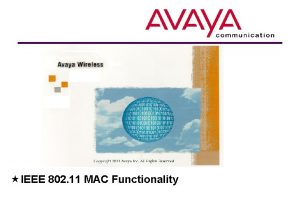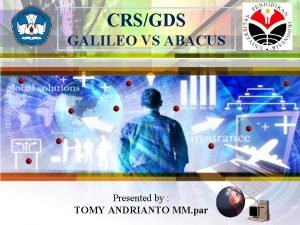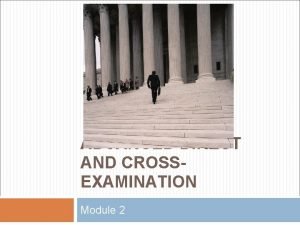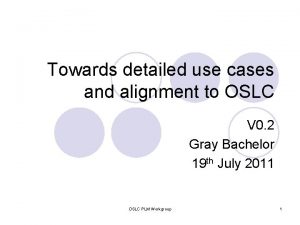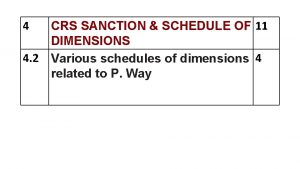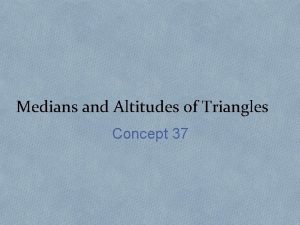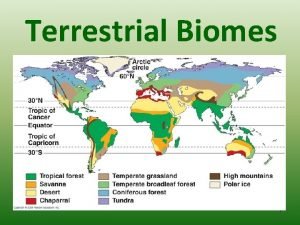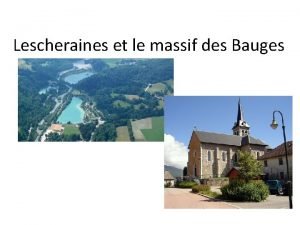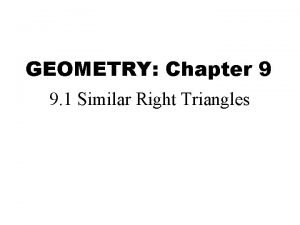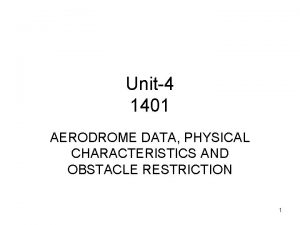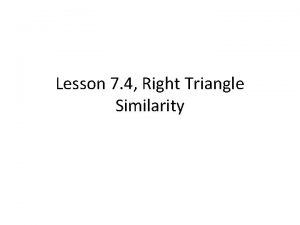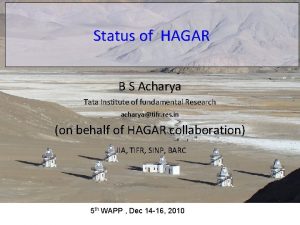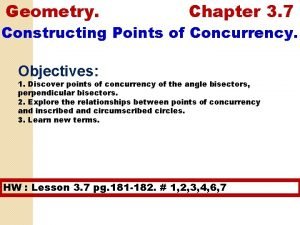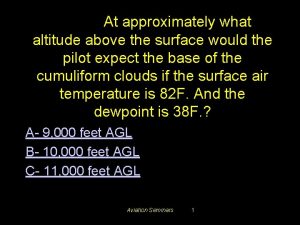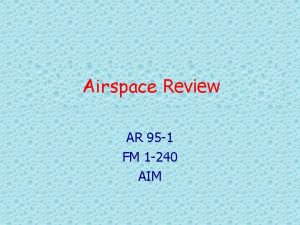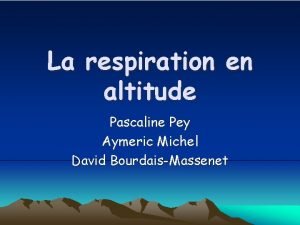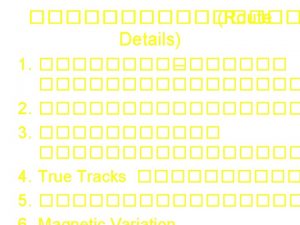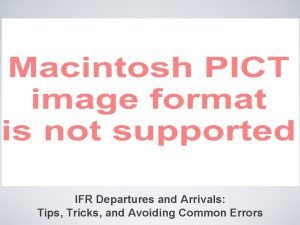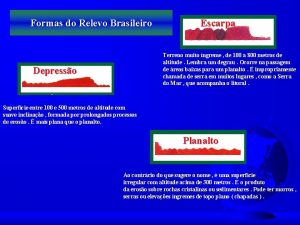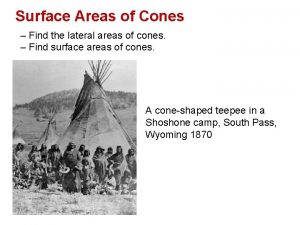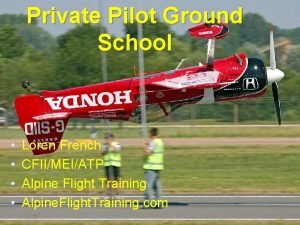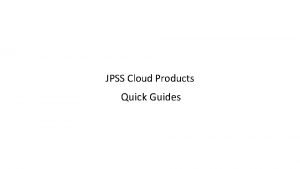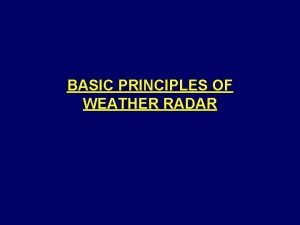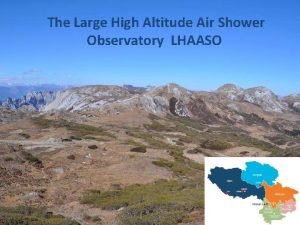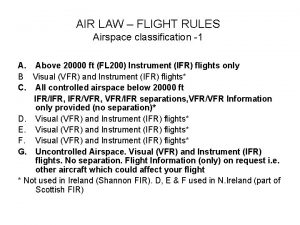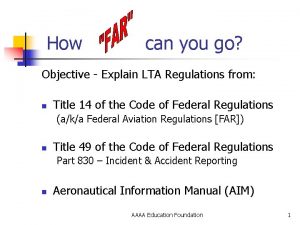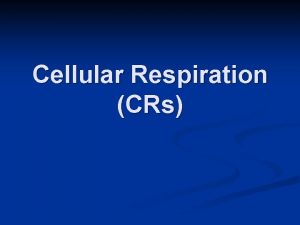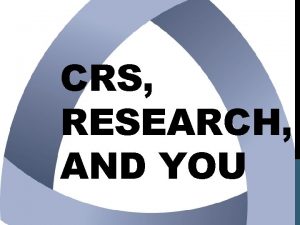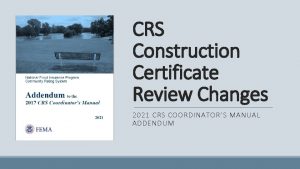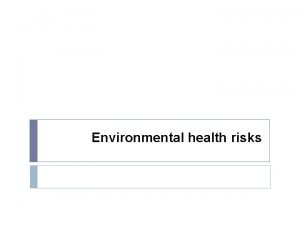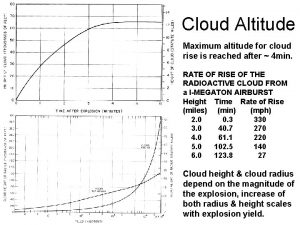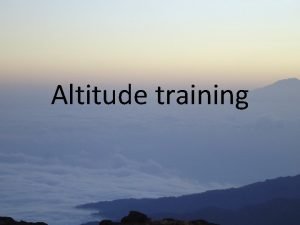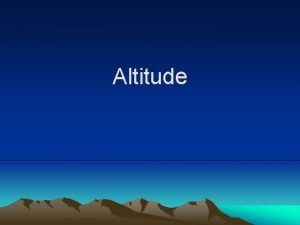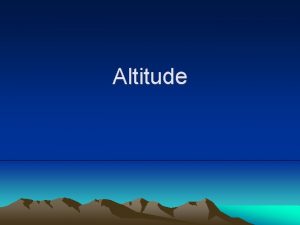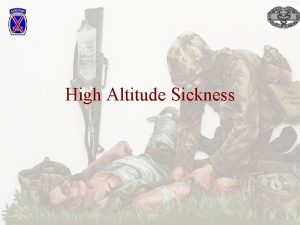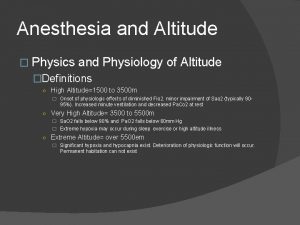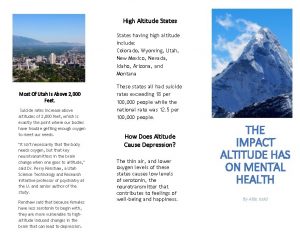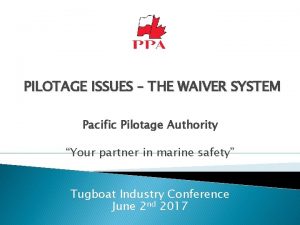Pilotage Things To Consider Altitude Mag Crs 0


















































- Slides: 50


Pilotage Things To Consider • Altitude • Mag Crs 0 to 179 = Odd + 500 • Mag Crs 180 to 359 = Even + 500 B A

Dead Reckoning (DR) VFR Cruising Altitude Rules 8, 500 ft MSL 7, 500 ft MSL 180° - 359° Even Thousands + 500 ft Above 3, 000 ft AGL 0° - 179° Odd Thousands + 500 ft Magnetic Course Jeppesen Sanderson, Inc. 1998 All Rights Reserved Guided Flight Discovery Private Pilot Manual

Dead Reckoning (DR) Flight Planning Check the Weather Process • • Select a Route • Choose a VFR Cruising Altitude When flying course 175 and for wind correction, Flying heading 185. What is flight altitude?

Dead Reckoning (DR) Magnetic Course / Cruising Altitude Magnetic Course: 008° WIND Magnetic Heading: 355° Correct VFR Cruising Altitude: Odd Thousand Plus 500 Feet Jeppesen Sanderson, Inc. 1998 All Rights Reserved Guided Flight Discovery Private Pilot Manual

• Dead Reckoning (DR) Flight Planning Check the Weather Process


Dead Reckoning (DR) Flight Planning Check the Weather Process • • Select a Route Checkpoints - Performance - Airspace - Fuel

Dead Reckoning (DR) Flight Planning Check the Weather Process • • Select a Route • Choose a VFR Cruising Altitude • Consider Fuel Requirements

�������� Normal planning • When planning to an intended destination with alternate, the minimum amount of fuel to be on board the aircraft is the Minimum Ramp (Block) Fuel = Taxi Fuel + Trip Fuel + Contingency Fuel + Alternate Fuel + Final Reserve Fuel.

�������� • Ramp (block) fuel = The total fuel on board the aircraft before starting engines. • Taxi fuel = A standard quantity to cover APU consumption, engine start, and ground maneuvers until a start of takeoff. • Takeoff fuel = Ramp fuel minus taxi fuel.

�������� • Trip fuel = The fuel required to fly from the aerodrome of departure to the planned destination, based on planned operating conditions. This amount shall include fuel for takeoff, climb following a normally used SID giving longest distance, normal cruise, descent to initial approach fix, approach to the least favorable runway and landing.

�������� • Contingency Fuel (CF) = Fuel required to cover deviations during flight from the “Planned operating conditions” as well as to provide operational flexibility in case of inflight malfunction. When planning a flight, the CF shall be 5% of the planned trip fuel. Be reduced to a minimum of 3% of the planned trip fuel, provided an en route alternate is available

�������� • An en route alternate used for planning with reduced Contingency Fuel (CF) is an aerodrome which should be located within a circle with a radius equal to 20% of the total flight plan distance, the center of which lies on the planned route at a distance from destination 25% of the total flight plan distance, or 20% of the total flight plan distance plus 50 nm, whichever is greater.


�������� • Alternate fuel = The fuel required to fly from the planned destination to the respective alternate, based on the planned operating conditions. The alternate fuel will include fuel from the start of a missed approach following a normally used SID giving the longest distance, Climb, Long-Range Cruise, descent to main navaid, and approach to the least favorable runway and landing at alternate.

�������� • Final reserve fuel = Fuel required to fly for 30 min (Turbo Prop : 45 min) above the alternate aerodrome (or the destination when no alternate required) at: 1. Holding speed 2. 1500 ft ISA 3. Estimated weight.

ATC DETAIL • AIP: AERODROME INFORMATION PUBLISHCATION

• • • Dead Reckoning (DR) Flight Planning Check the Weather Process Select a Route Choose a VFR Cruising Altitude Consider Fuel Requirements Prepare the Nav Log v a N g o L

BC A D F G H I A. Route Column: Departure, Reporting Point, Turning Point, Check Point, Destination B. NAV Column: Freq & Code C. Report Column: RPT Call Sign D. MAG Heading Column: Magnetic Course & Drift E. Distance Section: Total Distance, LEG / Remain F. ETE/EST Total Column: Estimate Time En-Route G. ETA / ATA : Estimate Arrival / Actual Time Arrival H. Ground Speed Column: EST. GS I. Fuel Section: Total AMT Fuel, EST LEG/Remain, Actual Fuel Remain J. Position Report K. Destination Airport Information E J L.

A. Emergency Field Section B. GCI or UHF/DF Station Section: Location, Callsign C. Takeoff Data Section D. Miscellaneous Data Section

�������� ��� Flight plan • Heading • Speed • Time



����� (Track) NO Turning Radius NDB Visual Turning Point (Town) 1 ½ Turning Radius


������� (Distance) 100º Track NDB Change 2 ½ NM added 150 to distance 130 120 110 160 100 Visual Turning Point (Town) 170 180 190 10 20 30 40 50 60 1 ½ Turning Radius


������� (Safety Heights( • ������� (Safety Heights) – ������������ Course Arrow • Aerodrome Control Boundaries • Check Points – ������������� Track





จดเลยว (TURNING POINT) • SET HEADING ขาตอไป • REPORT POSITION • CHECK ETA • เลยวถอ HEADING ใหม • แกไข ETA • ทำ CLEAR CHECK

การลดระยะสง (DESCENT PROCEDURE) • ขออนญาต ATC • ทำ BEFORE DESCENT CHECK

Lost Procedures

Lost Procedures CLIMB COMMUNICATE CONFESS COMPLY CONSERVE




One – In – Sixty Rule 60 NM A 1 ��� 60 NM 1 NM

������� Correction to parallel C Correction to converge Distance off A Distance flown Distance to fly B Correction angle to parallel X 1/60 = Distance off Distance flown Distance off Correction angle to converge X 1/60 = Distance to fly

������ 02: 10 A 15 NM 8 3 1 2 NM G D H HDG 15 0 C ���� 02: 22 Correction angle to parallel X 1/60 = ���� =? B Correction to converge Correction to parallel Distance off Distance flown Distance off X 60 Distance flown Correction angle to parallel = = 2*60 15 = 8 ����

Correction angle to parallel = 8 ���� HDG ���� 150 HDG ���� 138 ������� 12 ���� Correction angle to converge = 12 -8 = 4 ������� Distance off Correction angle to converge X 1/60 = Distance to fly ��� Distance off X 60 Distance to fly = Correction angle to converge = 2*60 4 = 30 NM


• Time to Station = Time for Bearing Change (minutes)× 60 Degrees of Bearing Change • Distance to Station = Time for Bearing Change (minutes)× 60 Degrees of Bearing Change

• ���� TAS • Wind effect Effect on GS Effect on Drift

Question?

Map Reading • It is the identification of landmarks from their representation on a chart and therefore utilization of this information to fix the position of the aircraft or to establish lines of position.

Advantages and Limitation of Map Reading Advantages • The best means of checking dead reckoning • No fix is more precise than a positive identification of an accurately mapped landmark. Limitation • It cannot be used when the ground is obscured by clouds or when flying over water • Landmarks cannot always be readily identified on a chart such as at night or if the chart is incomplete or inaccurate.
 Pilotage
Pilotage Salle de pilotage stratégique
Salle de pilotage stratégique Pilotage
Pilotage Pilotage navigation
Pilotage navigation Pilotage
Pilotage Pilotage pedagogique directeur ecole
Pilotage pedagogique directeur ecole Tissage etayage pilotage
Tissage etayage pilotage Latitude and longitude aviation
Latitude and longitude aviation Vrs and crs
Vrs and crs Eldy lombardia
Eldy lombardia Vi1 certificate
Vi1 certificate Crs rice bowl app
Crs rice bowl app Waf что это
Waf что это Crs sanction in railway
Crs sanction in railway Crs oyo
Crs oyo Crs-4-fc
Crs-4-fc Crs gds
Crs gds Integrated crs
Integrated crs Crs
Crs Cisco crs-16/s-b
Cisco crs-16/s-b Ieee
Ieee Tomy
Tomy Crs 13-90-101
Crs 13-90-101 Plm crs
Plm crs Trolley refuge dimension
Trolley refuge dimension Computerised reservation system
Computerised reservation system Larimer county child protective services
Larimer county child protective services High altitude aeronautical platforms
High altitude aeronautical platforms Climograma tropical brasil
Climograma tropical brasil Medians and altitudes of triangles
Medians and altitudes of triangles Altitude and latitude
Altitude and latitude Lescheraines altitude
Lescheraines altitude 9-4 similarity in right triangles
9-4 similarity in right triangles Sun angles by season
Sun angles by season Minimum safe altitude chart
Minimum safe altitude chart Similar right triangle
Similar right triangle Sky altitude surat menu
Sky altitude surat menu The incenter is the center of the __________ circle.
The incenter is the center of the __________ circle. What clouds have the greatest turbulence?
What clouds have the greatest turbulence? Class d airspace dimensions
Class d airspace dimensions Pascaline pey
Pascaline pey 0-179 altitude
0-179 altitude Standard takeoff minimums
Standard takeoff minimums Formada por morros pontiagudos cristas
Formada por morros pontiagudos cristas Lateral area cone
Lateral area cone Alpine flight training
Alpine flight training Cloud base altitude
Cloud base altitude Aerostat radar barnala
Aerostat radar barnala Lhaaso
Lhaaso Transition altitude vs level
Transition altitude vs level Vfr weather minimum
Vfr weather minimum

